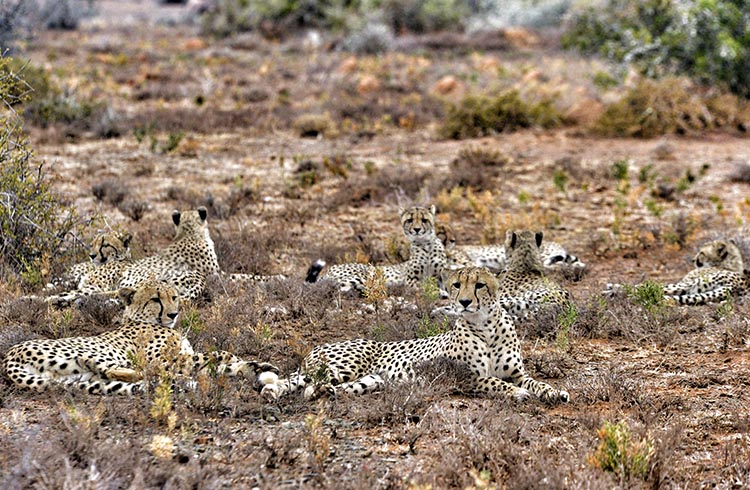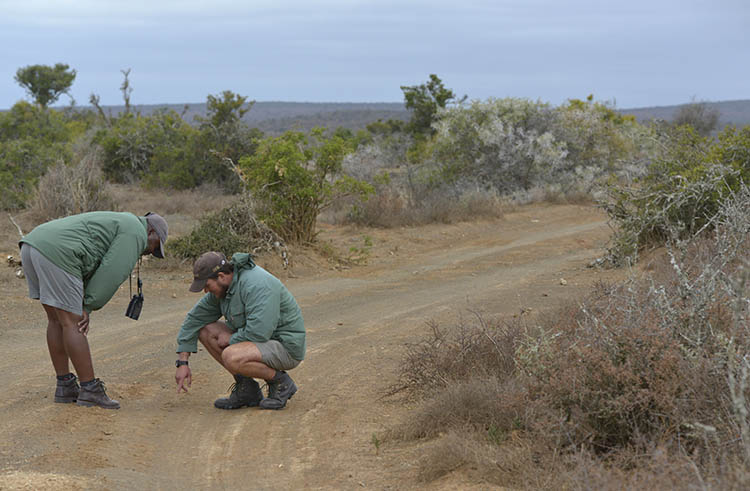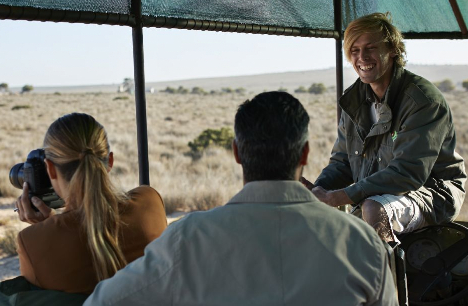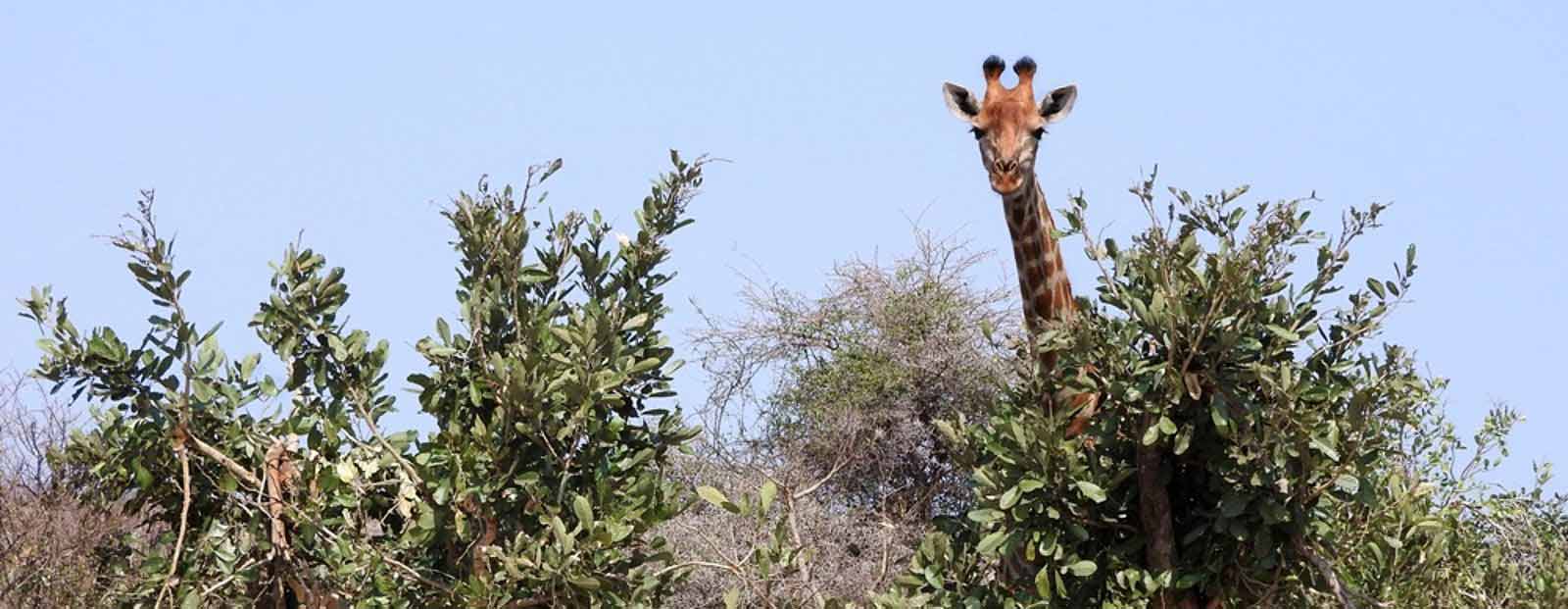Discover Kwandwe: South Africa’s Unsung Wilderness
Kwandwe Private Game Reserve offers intense wildlife sightings that would be unexpected even in far larger parks, yet it’s still relatively unknown, even in South Africa.
 Photo © Mark Eveleigh
Photo © Mark Eveleigh
This was clearly the strangest thing on four legs that the leopard had ever seen. He snarled threateningly, but the table didn’t even tremble.
I struggled to control my own excited trembling as I focused my Nikon. I’d never seen such a big leopard up close for so long and – standing halfway between me and my sundowner G&T – he was an intimidating sight.
I’d spent the last three days exploring Kwandwe Private Game Reserve, in South Africa’s Eastern Cape. These 85mi2 (220km2) of plains and craggy gorges offer intense wildlife sightings that would be hard to find even in far larger parks. With a maximum capacity of just 52 guests, the reserve provides the increasingly rare feeling that you’re alone in the immensity of the African wilderness. In the last few days, I’d perched in the back of the open Landcruiser just yards from hunting lions, and I’d had a grandstand VIP seat at several leopard hunting and courtship dramas. I’d even witnessed at close quarters the interactions of what could almost be described as a “pride” of cheetahs.
“It’s extremely rare for five cheetah siblings to survive to adulthood,” ranger Brendan Dredge whispered, “and it’s almost unheard of for a usually solitary old male to form a coalition with his fully-grown son. Then for the two groups to interact, even temporarily…well, this is the only place in Africa I’ve seen as many as eight cheetah in a single group!”
It was clear that relationships were strained, however, and that this rather dysfunctional family was not going to stick together for long.

A wildlife conservation success story
Brendan Dredge had the sort of intimate knowledge that can only come from years tracking animals, and his spotter colleague Mcebisi Yoli – known to his friends simply as “Dennis” – had spent his whole life with Kwandwe as his backyard.
“You see that shepherd tree by the cliff?” Dennis asked me one morning as we circled a herd of rare black wildebeest. “I used to sit in the shade under that tree 40 years ago, when this was a field, and my father was a laborer here on what was called Mowbray farm.”
The indigenous inhabitants of this area suffered heavily when this was a frontline in the Settler-Xhosa wars, and the wildlife was almost totally hunted out in the period that followed in the early 1800s, when Dutch and English settlers built their homesteads here. More than 180 years after Heatherton Towers, one of South Africa’s first ostrich farms, started exporting plumes to Europe, the building is now Kwandwe’s reception house. The historic farmhouse known as Uplands Homestead has been converted into a gorgeous safari venue.
All too often the reclamation of wild areas throughout Africa has turned local communities into refugees, frequently relegated to dismal camps in the buffer zones. Most of Kwandwe’s staff are ex-farm workers, however, and their lives have improved phenomenally since the decision was made, in 2001, to buy up nine white-owned farms and return the surrounding habitat to its wild state.
Kwandwe (“Place of the Blue Crane” in Xhosa) was named after the highly endangered and incredibly beautiful blue crane which had almost disappeared, but is now returning in healthy numbers. The fences were torn down and, in less than 20 years, Kwandwe has been transformed into a pristine wilderness where herds of elephants and both black and white rhinoceros roam.
There are three healthy prides of lions and a thriving leopard population in the reserve. Most spectacularly, cheetah were reintroduced and are now here in numbers that would have been inconceivable in the previous century, since the last two were shot in this area in 1888.

Taking the carbon out of your footprint
Brendan, Dennis, and I had driven many hours together over the last few days, but getting to know Kwandwe involves more than simple game-driving. We went fishing from an aluminium boat on Kwandwe dam, but our voyage was so eventful – with sightings of new-born hippo, two black rhino, countless antelope, and an entire family of frolicking otters – that we never even had time to cast our lines. Now, we were exploring on foot. Walking safaris offer a much deeper knowledge of the bush than the average safari. Kwandwe even offers children “poo safaris” in areas that are safely free from dangerous animals.
“Stay close, and try to keep noise to a minimum,” Brendan whispered as he slung his rifle over his shoulder. We set off walking in single file, with Dennis acting as rear guard. Having seen footprints almost constantly on every track we’d driven, I’d probably never been in an area where the possibility of spotting rhino was so good.
The bush around us was appropriately known as renosterveld (literally ‘rhino bush’) and was richly scented with olives, rosemary, curry bush, and a succulent known locally as spekboom (Portulacaria afra). Apart from being highly palatable to many herbivores, spekboom is one of the top five carbon-storing plants on our planet. It’s been estimated that 100 hectares of spekboom (Kwandwe is 22,000 hectares in total) is equivalent to taking 260 cars off the road for a year.
The reserve is a success story on a social level, too. Since 2002, Kwandwe’s social development arm has provided benefits that include a pre-school, primary school, and adult education, a community center, and a health program (not only for staff but also serving 10 nearby villages).
“My children can hope for a far better future than my father ever expected,” Dennis told me when the leopard finally moved on and let us approach our sundowners. “We have a community to be proud of here. When I grew up, the wildlife was just a threat to the farms, but now even the leopards seem to be our friends!”
Trip notes
Getting there
Lying approximately 100m (160km) by car from Port Elizabeth, at the end of the famous Garden Route, Kwandwe makes the perfect finale to a road trip from Cape Town. If you prefer to fly, Kwandwe has its own airstrip, but most visitors fly from Cape Town or Johannesburg to Port Elizabeth.
Costs
Kwandwe has of the highest land-to-guest ratios in South Africa, which is key to its conservation initiatives. But this experience doesn’t come cheap: suites range from US $619 per person per night at Ecca Lodge or Great Fish River Lodge to US $2,645 upwards for up to 5 guests staying in private safari villas. All accommodation includes full board with drinks, two game drives per day, nature walks, and big game tracking accompanied by an armed ranger and guide.
When to go
The region is malaria free year-round. Summer (October to March) is hot and wet, with temperatures soaring above 97°F (36°C). Winter (May to August) sees chilly mornings and evenings but produces clear, warm days with very little rain.
Related articles
Simple and flexible travel insurance
You can buy at home or while traveling, and claim online from anywhere in the world. With 150+ adventure activities covered and 24/7 emergency assistance.
Get a quote


No Comments